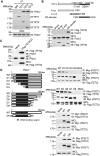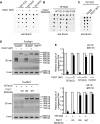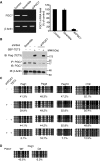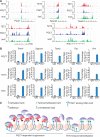PGC7 suppresses TET3 for protecting DNA methylation
- PMID: 24322296
- PMCID: PMC3950671
- DOI: 10.1093/nar/gkt1261
PGC7 suppresses TET3 for protecting DNA methylation
Abstract
Ten-eleven translocation (TET) family enzymes convert 5-methylcytosine to 5-hydroxylmethylcytosine. However, the molecular mechanism that regulates this biological process is not clear. Here, we show the evidence that PGC7 (also known as Dppa3 or Stella) interacts with TET2 and TET3 both in vitro and in vivo to suppress the enzymatic activity of TET2 and TET3. Moreover, lacking PGC7 induces the loss of DNA methylation at imprinting loci. Genome-wide analysis of PGC7 reveals a consensus DNA motif that is recognized by PGC7. The CpG islands surrounding the PGC7-binding motifs are hypermethylated. Taken together, our study demonstrates a molecular mechanism by which PGC7 protects DNA methylation from TET family enzyme-dependent oxidation.
Figures






References
-
- Jaenisch R, Bird A. Epigenetic regulation of gene expression: how the genome integrates intrinsic and environmental signals. Nat. Genet. 2003;33:245–254. - PubMed
-
- Suzuki MM, Bird A. DNA methylation landscapes: provocative insights from epigenomics. Nat. Rev. Genet. 2008;9:465–476. - PubMed
-
- Klose RJ, Bird AP. Genomic DNA methylation: the mark and its mediators. Trends Biochem. Sci. 2006;31:89–97. - PubMed
-
- Bird A. DNA methylation patterns and epigenetic memory. Genes Dev. 2002;16:6–21. - PubMed
-
- Martin C, Zhang Y. Mechanisms of epigenetic inheritance. Curr. Opin. Cell Biol. 2007;19:266–272. - PubMed
Publication types
MeSH terms
Substances
Grants and funding
LinkOut - more resources
Full Text Sources
Other Literature Sources

